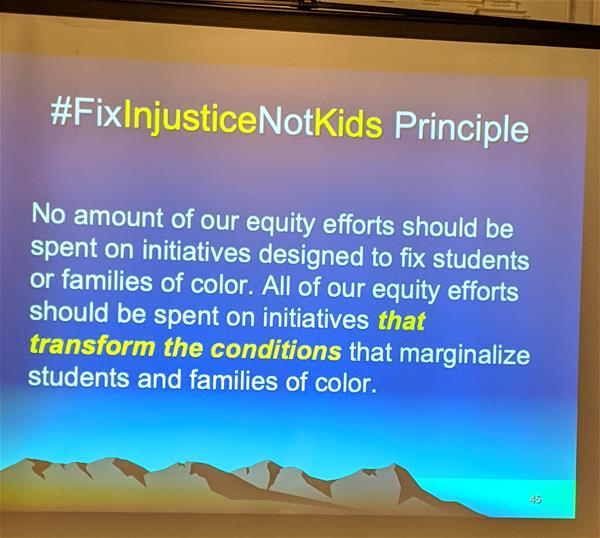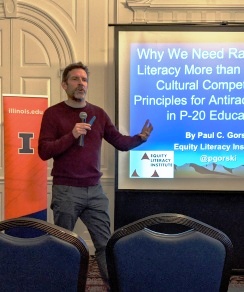Dr. Paul C. Gorski is the founder of the Equity Literacy Institute as well as EdChange, a free resource for K-12 educators. Gorski has built his career assisting educators in understanding and implementing social justice practices across multiple facets of education. As part of this semester’s Dean’s Diversity Lecture, he visited the University of Illinois at Urbana-Champaign on November 18 to share why the field of education needs to move toward racial equity literacy.
Gorski began his talk in a surprising way by challenging education institutions that are committed to equity and justice. He noted most education institutions or school districts have statements of equity and justice, but when it comes to actionable steps toward “racial justice or economic justice … things tend to get tricky.” Gorski said education institutions often create multicultural or diversity programming, but those forms of programming do not explicitly challenge the racism that is occurring on campuses and in schools.
Gorski posed an intriguing question regarding Dr. Martin Luther King Jr. He asked the audience, “If I walk into any school within the state of Illinois and I find a Martin Luther King Jr. poster, what is it going to say on that poster?” The crowd answered the poster would likely have King’s well-known “I have a dream” phrase plastered on it. Gorski then said:
“That is a lie about who Martin Luther King was … that is a lie. Why do we lie? Why have we taken the fluffiest, most depoliticized thing Martin Luther King Jr. ever said or wrote and made that the legacy of Martin Luther King Jr.? Why do educational institutions do that?”
The key is to identify, communicate, comprehend, and eliminate the social identity-based oppression.
The short answer to Gorski’s question lies in the safe-sounding resonance of King’s popular four words. He then made the connection that education institutions take the easy and safe course when it comes to equity and justice. That safety, Dr. Gorski noted, is meant for white people because it creates the idea that institutions care about equity and justice, yet no actionable steps are taken to rectify racism, racial inequities, or undo harmful white racial ideologies. Instead of focusing on the racial discomfort and racial oppression that people of color face within the education system, education institutions often focus on making sure white people within them are comfortable and feel safe.
Because the progression of racial equity is slowed by white people within education, Gorski outlined four critical steps educational organizations and stakeholders must take: 1) recognize inequity, 2) respond to inequity, 3) redress inequity, and 4) sustain equity.
These steps first ask stakeholders in education if inequities are happening at their institution, and if so, individuals must then take the initiative and have the knowledge to recognize, respond to, and remedy inequities while sustaining equity. In further discussing the above steps, Gorski connected disparity ideologies to solve inequities within education. Deficit ideologies, it should be noted, focus on fixing marginalized people instead of fixing the system of education that is not correctly serving them.
An example Gorski gave of a deficit ideology was that working-class families do not value education because they don’t show up at their children’s schools. However, as Gorski noted, parents within working-class backgrounds often do not have the resources to access the school during the day or directly after the school day ends. The issue is not if working-class parents care about their children’s schooling; the issue is if they have the resources (e.g., paid leave, transportation, child care) to visit the school. This topic is often racialized, classed, and gendered based on the social identities of the parents. Ignoring the “isms” (e.g., racism, classism, sexism) within society, as well as how they affect students and their families, is a part of the deficit ideology.
 A form of a deficit ideology Gorski covered near the end of his talk was grit. The grit ideology refers to the isms and structural barriers within society and advocates that marginalized communities must be active in order to overcome structural barriers instead of working to undo them. Gorski said education institutions and stakeholders should challenge deficit ideologies and remove social identity-based barriers, inequities, and injustices that students and their families regularly face.
A form of a deficit ideology Gorski covered near the end of his talk was grit. The grit ideology refers to the isms and structural barriers within society and advocates that marginalized communities must be active in order to overcome structural barriers instead of working to undo them. Gorski said education institutions and stakeholders should challenge deficit ideologies and remove social identity-based barriers, inequities, and injustices that students and their families regularly face.
Gorski concluded his talk by offering principles to guide equity work, one of which was direct confrontation. Without direct confrontation of racial inequities and racism at an education institution, he said, racial oppression will remain. The key is to identify, communicate, comprehend, and eliminate the social identity-based oppression. While equity and justice programming is necessary, education institutions and stakeholders must directly confront the racial inequities and racism. After doing so, they must then reimagine policy and practice in ways that support, prioritize, and uplift students of color.
Gorski’s final principle called for education institutions and stakeholders to commit to fixing injustice at institutions—not fixing the students. Equity- and justice-based efforts should be created to change the unfair conditions people of color experience within the education system rather than creating programming designed to fix these individuals, he said.




Leave a comment